It started with a countdown. Ten, nine, eight… a group of kids huddled behind a yellow safety line, eyes locked on the slender rocket balanced on its red launcher. The button was pressed, and in a burst of smoke and speed, the rocket shot into the blue August sky. Cheers erupted. For a moment, every child in Warrington’s Lower Nike Park believed they had touched the stars.
This was Space Exploration Day, a hands-on STEM event hosted by local Scouts. Dozens of fourth and fifth graders gathered with troop leaders and volunteers to build model rockets, learn the basics of flight, and—most importantly—experience the thrill of seeing their hard work leave the ground.

Learning by Doing
There’s something powerful about moments like this. In a classroom, a physics equation might feel abstract. But with glue-sticky fingers and rocket fins spread across picnic tables, Newton’s laws suddenly come alive.
Throughout the day, kids:
-
Built and decorated rockets at long tables filled with parts and instructions.
-
Worked in teams, guided by leaders who explained stability, aerodynamics, and safety.
-
Launched rockets into the sky, each countdown building anticipation and each flight sparking wide-eyed wonder.

Twelve-year-old Brandon, helping document the day, interviewed some of the young rocketeers. Their answers captured the raw imagination of the event.
Bryan, when asked how he’d react inside the Johnsville Centrifuge where astronauts once trained, laughed: “Probably pass out.” Still, he dreamed of planting a flag on the Moon one day.
Robert took a different approach. If given the chance to ride his rocket, he said he’d “fly into the sun because I want to experience extreme heat.” His reasoning? “I don’t know why, I just do.”
Joseph admitted he’d rather ride his rocket home because “it’s comfortable there,” but when asked about training like an astronaut he said simply, “I would be amazed.”
And Abby—who wasn’t building her own rocket but was helping others—summed up why these events matter: “I wish I had more experiences like this when I was a Cub. I think being able to do STEM through Scouts is really nice for them.”

State Representative Brian Munroe, present with camera in hand, tried to capture one launch in slow motion. He later reflected:
“This was such a fun and educational STEM event for kids. Watching their reactions as the rockets flew—it’s magic. My office is committed to supporting more events like this across our district.”
From Warrington to Warminster’s Legacy
This event might look like child’s play, but it echoes a larger story. Just a few miles away in Warminster, Pennsylvania, America’s first astronauts once trained in the world’s most powerful centrifuge. Before Neil Armstrong or John Glenn ever launched into space, they sat inside that spinning machine at the Naval Air Development Center, enduring crushing G-forces to prove the human body could survive the journey.
Programs like Project SPARC, founded in Northeast Philadelphia, have long continued this tradition of connecting students to aerospace science. Days like Space Exploration Day carry that torch forward—reminding us that space exploration doesn’t begin in Houston or Cape Canaveral. It begins with a spark of curiosity, often right in our own backyards.

Why STEM Events Matter
Events like these do more than entertain. They:
-
Inspire early dreams — kids who launch paper or model rockets today might design the next Mars mission tomorrow.
-
Teach resilience — not every rocket flies perfectly, and that’s part of the lesson. Astronaut training itself is built on learning from failure.
-
Build community — kids, parents, and leaders work together, modeling the teamwork essential in aerospace.
As astronaut Sally Ride once said, “You can’t be what you can’t see.” Space Exploration Day let kids see themselves as explorers.
Looking Up, Looking Forward
Watching those rockets soar above Warrington, I couldn’t help but think of the continuum: from John Fitch’s steamboat on the Delaware in 1787, to astronauts spinning in Warminster’s centrifuge, to Scouts cheering as their rockets pierced the sky. The story of American ingenuity isn’t written only in laboratories and spaceports—it’s written in fields, parks, and classrooms where kids first imagine what’s possible.
And maybe, just maybe, one of those kids—Bryan, Robert, Joseph, or Abby—will be the first human to set foot on Mars.
Support the Film
Help us tell the stories of space pioneers like Terry Hart.
• Visit BeforeTheMoonFilm.com
• Support the film through our donation page
• Follow us on Facebook: facebook.com/BeforeTheMoonFilm
Because before we go forward… we need to remember who got us here.


Leave a Reply